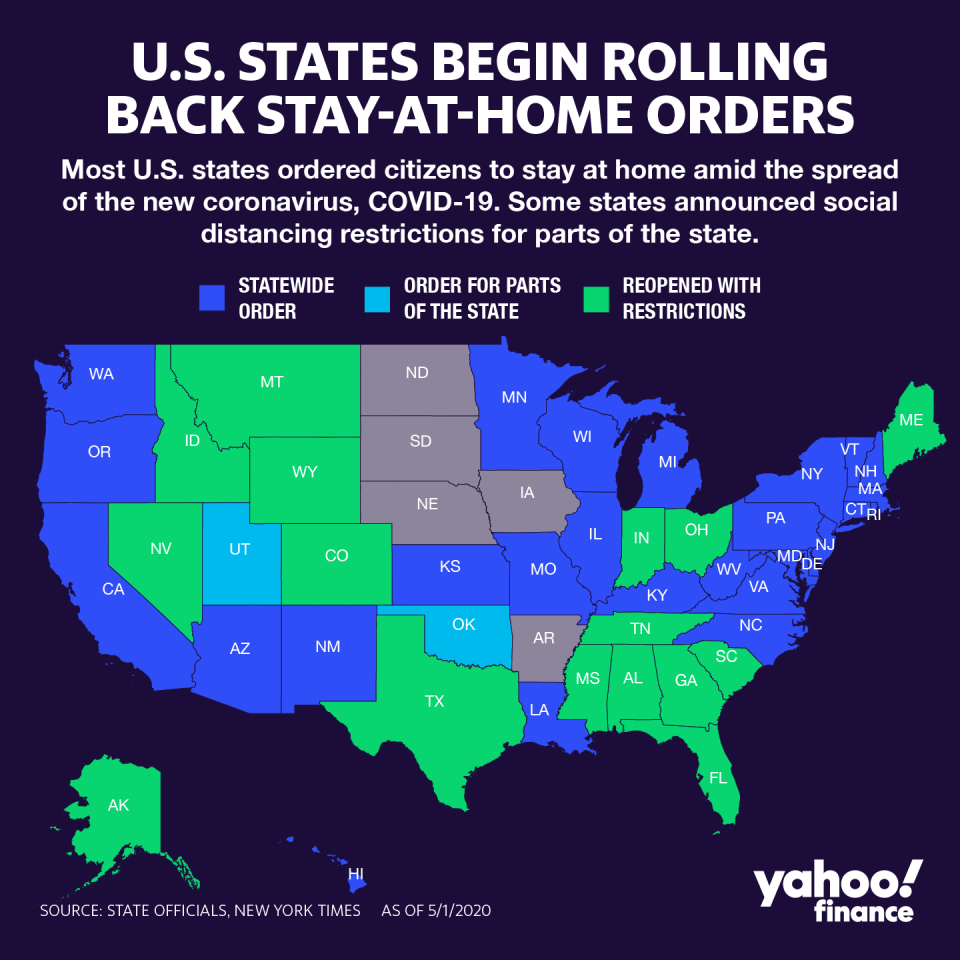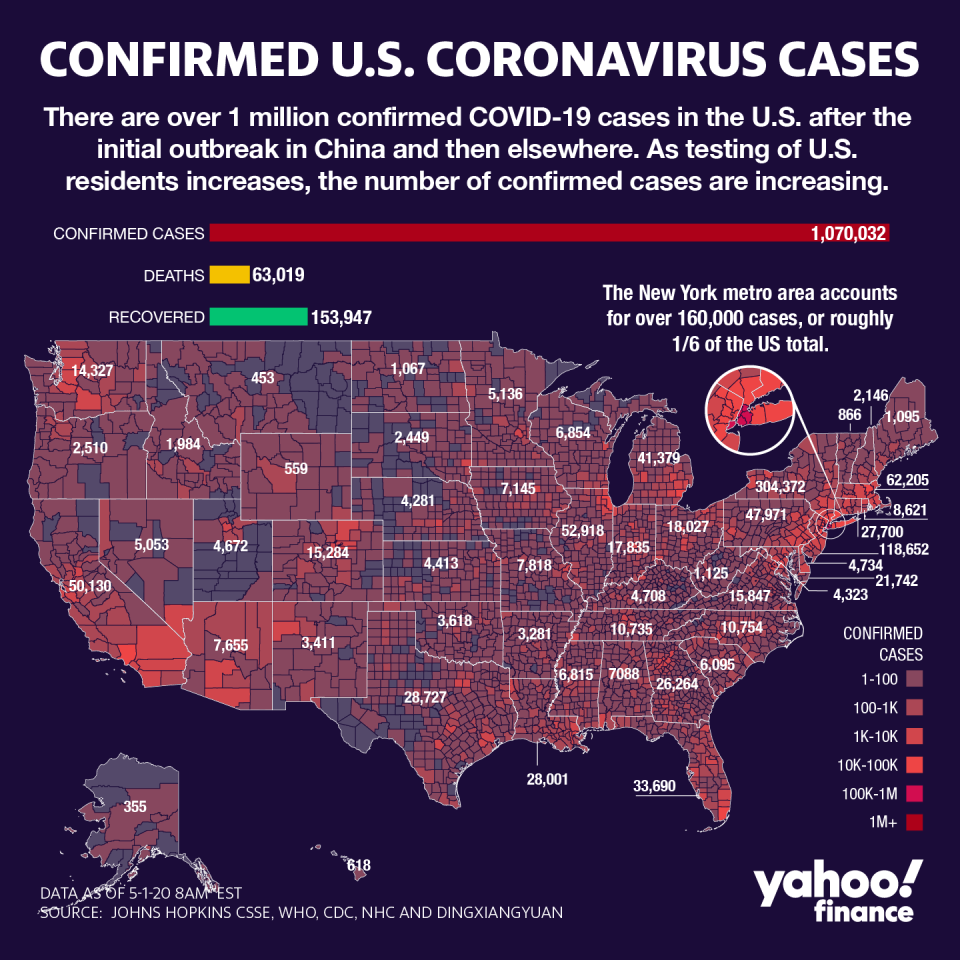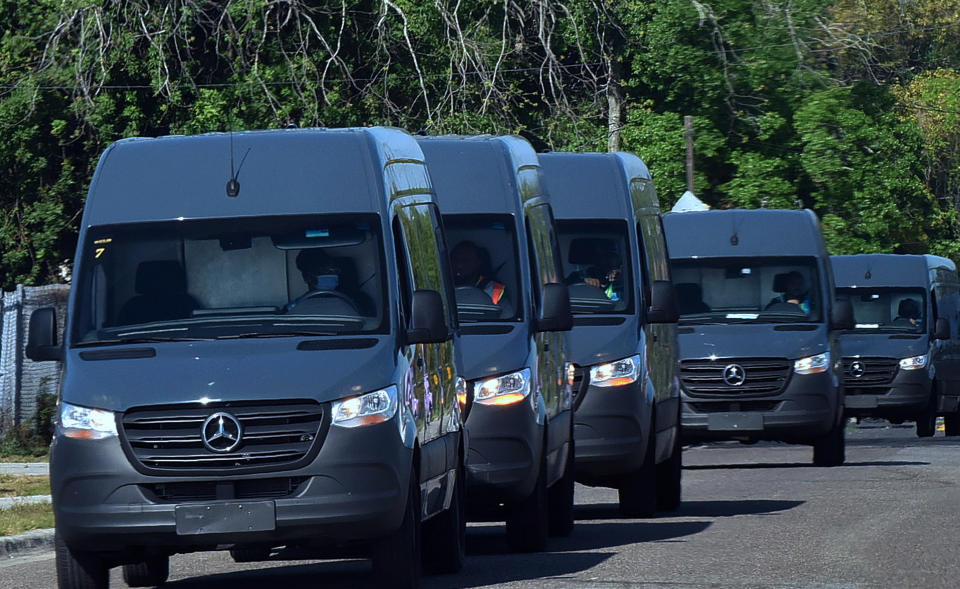Coronavirus update: US states map out reopen strategy as fear creeps back into market
A number of U.S. states took additional steps Friday to begin relaxing their lockdowns, even as fears about the coronavirus’ economic fallout resurfaced in the market and protests erupt over working conditions in supermarkets.
In a major development, the Food and Drug Administration approved Gilead’s (GILD) experimental COVID-19 treatment for emergency use, days after studies showed the drug had shown effectiveness in helping patients recover from the virus’ effects.
The global pandemic has wreaked havoc on the global economy, and in the U.S., some states have suffered significantly from halting all but essential businesses. The outbreak has cost over 233,000 lives globally, and infected more than 3.2 million.

New York and New Jersey continue to be the hotspots in the U.S. outbreak, with nearly 1.1 million confirmed cases on more than 63,000 deaths. Yet both have seen sustained decreases in new cases and hospitalizations — even though the Empire State officially cancelled public schools for the remainder of the academic year. Meanwhile, Massachusetts reported more than 62,000 cases Friday.
The virus’ impact on companies continued to be felt Friday as major benchmarks fell after a number of major tech earnings, including Amazon (AMZN) and Apple (AAPL), underscored how the virus has battered their bottom lines.
Workers protest conditions

Separately, amid widening fears about the U.S. food supply — with prompted at least one major grocer limiting beef and chicken purchases — big box retail and grocery store workers coordinated a strike Friday to call attention to working conditions, and the need for adequate workplace protections.
Warehouse and store workers for Amazon, Instacart, Target (TGT), Trader Joe’s, Walmart (WMT) and Whole Foods were among the May Day strikes. Many have demanded hazard pay for putting their lives at risk while serving as essential workers.
Patricia Campos-Medina, a labor union consultant and faculty at the School of Industrial and Labor Relations at Cornell University, told Yahoo Finance that companies have been slow to respond to workers’ needs, which is why protestors are risking being fired.
“The cost-benefit analysis for workers taking action used to be if I take action, I may lose my job,” she said. But amid the pandemic, “the cost-benefit analysis today is if I don’t speak out, I will get sick and I will get my family sick and I might die,” she added.
Rebecca Kolins Givan, associate professor of labor studies and employment relations at Rutgers University, told Yahoo Finance the strikes Friday were a significant move.
“This action will doubtless lead to union organizing drives and more sick-outs and walk-outs,” she said. “Strikes are contagious.”

Health care’s double-edged sword
Meanwhile, the U.S. House focuses on the next stimulus package, which could include as much as $1 trillion for state governments, concerns remain about which industries will be included. Among those being watched closely is are health insurers.
Though the companies have largely agreed to cover costs associated with COVID-19, many are getting a financial boost from the savings of deferred treatments and elective procedures.
This has also spilled over into employer-sponsored plans, according to a new study from Willis Towers Watson (WLTW). The study shows employers could be saving up to 4% on health care costs, if they remain outside a hard-hit zone.
With treatment for COVID-19 top of mind, people have been putting off nonemergency medical care, including routine office visits and elective procedures at hospitals,” said Trevis Parson, chief actuary at Willis Towers Watson.
“Given this reduction in use of medical services, we expect cost reductions due to care deferral to more than offset projected cost increases associated with COVID-19 infections,” he added.
The study analyzed the savings based on the outbreak’s impact in different parts of the country, with savings largely dependent on whether the affected region is rural or urban.
At a 1% infection level (rural areas) employer costs could decline between 1% and 4%, depending on how much medical care is deferred. At a 15% infection level (metro areas), employer costs could rise or fall by roughly 1% depending on care deferral, according to the analysis.
In the most severe scenario — a 20% infection level — costs could rise between 1% and 3%, yet still below projections from the earlier analysis.
[Click here for more of Yahoo Finance’s coronavirus coverage: Personal finance tips, news, policy, graphics & more from Yahoo Finance]
Anjalee Khemlani is a reporter at Yahoo Finance. Follow her on Twitter: @AnjKhem
Follow Yahoo Finance on Twitter, Facebook, Instagram, Flipboard, LinkedIn, and reddit.
Find live stock market quotes and the latest business and finance news.
